The Silverstone ST30SF & ST45SF SFX Power Supply Review
by E. Fylladitakis on January 26, 2017 9:00 AM EST- Posted in
- Cases/Cooling/PSUs
- PSUs
- 80Plus Bronze
- SilverStone
- SFX
- ST30SF
- ST45SF
External Appearance
The ST30SF and the ST45SF are externally identical, with the only apparent physical difference being the sticker on the side of their chassis. Even when it comes to the cables and connectors, the ST45SF only has one extra 8/6-pin PCIE connector, hinting that SilverStone expects the ST45SF only to be used if the PSU has to power a modern gaming graphics card. The designer’s logic is sound, as the number of drives that can be installed inside a compact chassis that has been designed for SFX PSUs usually is very limited, leaving no other device to require substantial levels of power other than a powerful GPU.
The ST30SF and the ST45SF feature a simple steel chassis that has been sprayed with a typical matte black paint. It is a very smooth paint job but the paint is highly prone to fingermarks. SilverStone placed the sticker with the electrical specifications on the left side of the chassis and small stickers with the unit’s serial number, version, etc., on the right side of the chassis. You can easily tell if the units are the latest or an older version by just looking at their fans: the newer ST30SF V2.0 and the ST45SF V3.0 models have 92 mm fans that barely fit into the body of the PSU, the older versions were using smaller 80 mm fans.
The company logo is once again engraved at the top of the unit, a technique that SilverStone performs on most of their PSU products to date. Despite the very small size of the chassis, the designer managed to find room for a small on/off switch next to the AC cable receptacle. The front of the PSU is plain, with just a hole for the hardwired cables to come out from. The cable arrangement is typical for the price range of these units, with color-coded wires covered in black nylon sleeving.
Internal Design
Whereas the ST30SF and the ST45SF externally are practically twins, there are significant differences on the inside of the units, which was to be expected considering that the ST45SF has 50% greater power output over the ST30SF. The first slight difference is their fan. Both of the simple black 92 mm low profile fans are supplied by Globe and are of the same series, but they are different models, with the ST30SF having a S0921512M and the ST45SF having a S0921512H installed. These fans have a “DURO” bearing engine, which is an enhanced version of a sleeve bearing that has been engineered for longevity. Their difference is that they have different speed ratings, with the former having a maximum speed of 2500 RPM and the latter of 3000 RPM.
A quick look on the inside reveals that both units share the same OEM and are based on the same platform, however there are great differences on the sizing of their components. Regardless of the electronic component sizes, it is worthwhile to mention that the main heatsinks remain identical, hinting that the extra cooling required to dissipate the higher energy losses of the ST45SF will be coming from its more powerful cooling fan. High Power is the OEM behind these two PSUs, a company mostly reputable for their balanced performance-to-cost designs.
The core design of the ST30SF/ST45SF is relatively simple technologically, with the designer obviously striving to deliver reliable, high quality power without caring about maximizing the product’s efficiency. Both units share the same components up to the input conversion bridge, with a filtering stage consisting of four Y capacitors, two X capacitors and two filtering inductors. The only difference here virtually is that the input conversion bridge of the 450W version has its own heatsink whereas the bridge in the 300W version has no heatsink at all.
SilverStone ST30SF Internal View
From here on, the design of both units remains the same but the size of the electronic components, both active and passive ones, differs greatly. The most apparent difference is the primary APFC capacitor, with a 180μF/400V capacitor in the ST30SF and a nearly a twice as large 330μF/400V capacitor in the ST45SF. Both are supplied by Japanese companies, Nichicon and Nippon Chemi-Con respectively. The smaller electrolytic capacitors in both units are supplied either by Nippon Chemi-Con or by Teapo, which is a good quality selection of products for cost-efficient PSUs.
SilverStone ST45SF Internal View
Two transistors on the primary side of the transformer form an asymmetric half-bridge inversion stage and four transistors on the secondary side form the synchronous rectifier for the 12V output. The 3.3V and 5V outputs are generated by DC-to-DC circuits found on the small vertical PCB. Despite the presence of the DC-to-DC conversion circuits and the synchronous rectifier, these units only reached up to an 80Plus Bronze certification, hinting that we might be dealing with high internal temperatures at higher outputs.



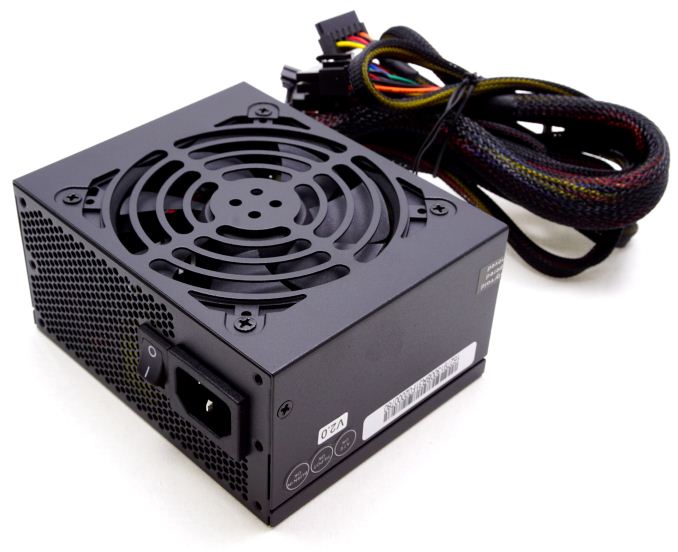
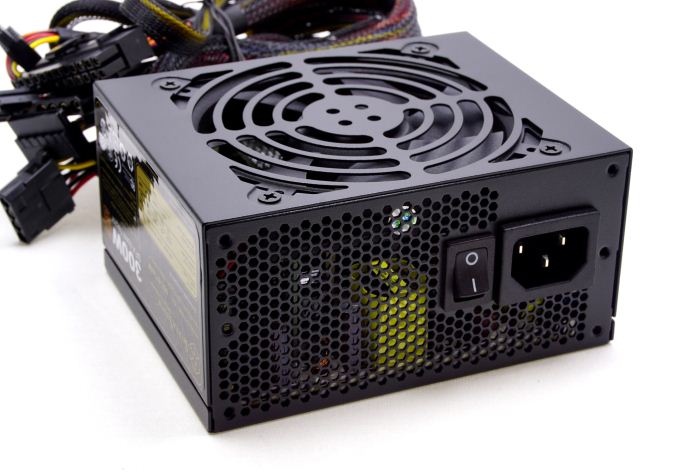

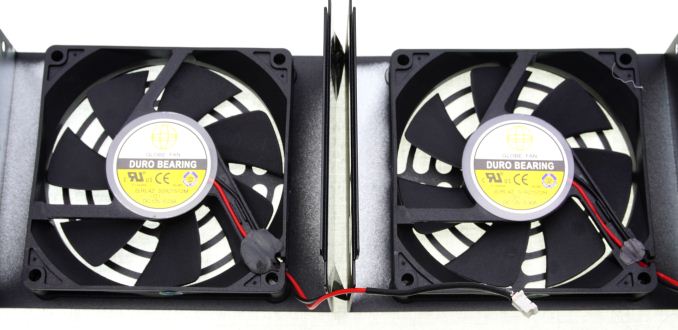
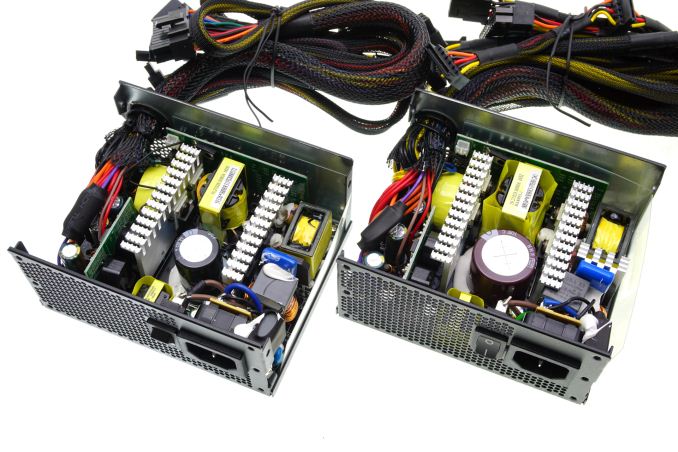



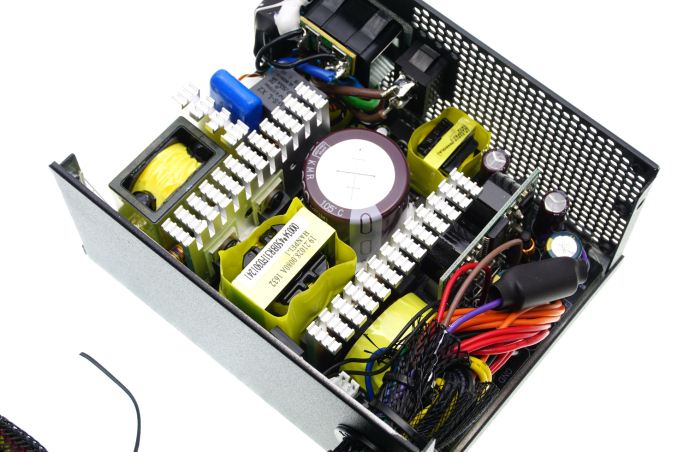








30 Comments
View All Comments
hasseb64 - Thursday, January 26, 2017 - link
Bronze? Wouldent installed one for free...A5 - Thursday, January 26, 2017 - link
The difference between Bronze and Titanium at 450W 100% load is 36W (roughly $38/year if you run 100% 24/7/365).Which isn't nothing, but it isn't a huge deal down in this power range.
TurboTastic - Thursday, January 26, 2017 - link
I totally would install one for free, and $45 is close enough to free to make it an easy choice!Yes, bronze is the minimum of the 80Plus certification. But it still means that it's 80Plus, which is better than a lot of the competition at this price point.
And what do you lose? 10W on standby, or 20W during the few minutes a day when you're really pushing the little Celeron kiosk you'd put this into? You could spend $90 on a Corsair SF450 Gold unit, or $160 on a Silverstone Platinum SX700. Even if those units had zero standby power consumption (they don't, the platinum still burns like 7W on standby), that $45 difference would buy like 4 years of electricity. You could run it for more than a decade on the SX700 before breaking even.
It's the right choice for the sign-in kiosk in the lobby, or a thin Word/Excel/Outlook client in the office. It's a fine choice for a NAS, or a media server in a closet. This is the right choice for the little Facebook machine you want to build for Grandma. And I depend on reviews like this from Anandtech so I can pick quality budget components for those machines! I'd probably be looking for a 300-500W ATX form factor power supply for 80% of my builds, and a small form-factor PSU like this one in this same power range for another 15%. Only a tiny fraction are the monster workstations and servers that need big, efficient power supplies.
Thanks, Fylladitakis, for another review of a typical power supply!
DanNeely - Thursday, January 26, 2017 - link
The minimum level is just 80 Plus, Bronze is the first step up above it. That said, especially at the 300W level just 80+ Bronze is better than most of what's on the market. Especially since this appears to be a modern 12V first design, vs a lot of the other junk on the market being old split rail designs.https://en.wikipedia.org/wiki/80_Plus#Efficiency_l...
80-wattHamster - Monday, January 30, 2017 - link
80+ is a certification based solely on efficiency, and has nothing to do with output quality or durability. It's true that in today's market, the marketing pull of 80+ being what it is, that a non-rated model isn't likely to be any good. But the rating by itself is nigh-meaningless in determining if a given unit is any good.romrunning - Thursday, January 26, 2017 - link
The SG05 that I bought with the 450W SFX PSU is still going strong. I really don't hear the fan in the PSU at all. It seems to be quieter than the CPU's fan in this min-ITX case.hybrid2d4x4 - Thursday, January 26, 2017 - link
Thanks for reviewing these smaller, relatively lower-power-rated PSUs!Props for the segment on "how picking an oversized PSU can lead to inferior overall performance", though I find it odd how this never gets mentioned in the reviews of idiotically oversized PSUs that are positioned at mainstream users (600-700W). These units get panned for being only bronze efficiency, but in the power draw situations of single-GPU systems, they would be a lot more efficient in the idle/light-usage state and possibly better while gaming compared to a PSU that is only at 30% load (in the case of a 700W).
StrangerGuy - Tuesday, January 31, 2017 - link
Yeah, it's really funny and idiotic with all that "ZOMG you need a 600W+ PSU or your PC will explode" PSU memes all around....For a typical gaming single GPU PC that idles ~50W and maybe touch 300W at full load where a 600W+ PSU will run so far away from the sweet spot on the efficiency curve.phexac - Thursday, January 26, 2017 - link
I generally stay away from commenting on the actual items you guys review, but I have to wonder here...how many people actually care about power supply reviews? Seems like there are plenty of other things to review out there...galta - Thursday, January 26, 2017 - link
Maybe the do not care, but they should.